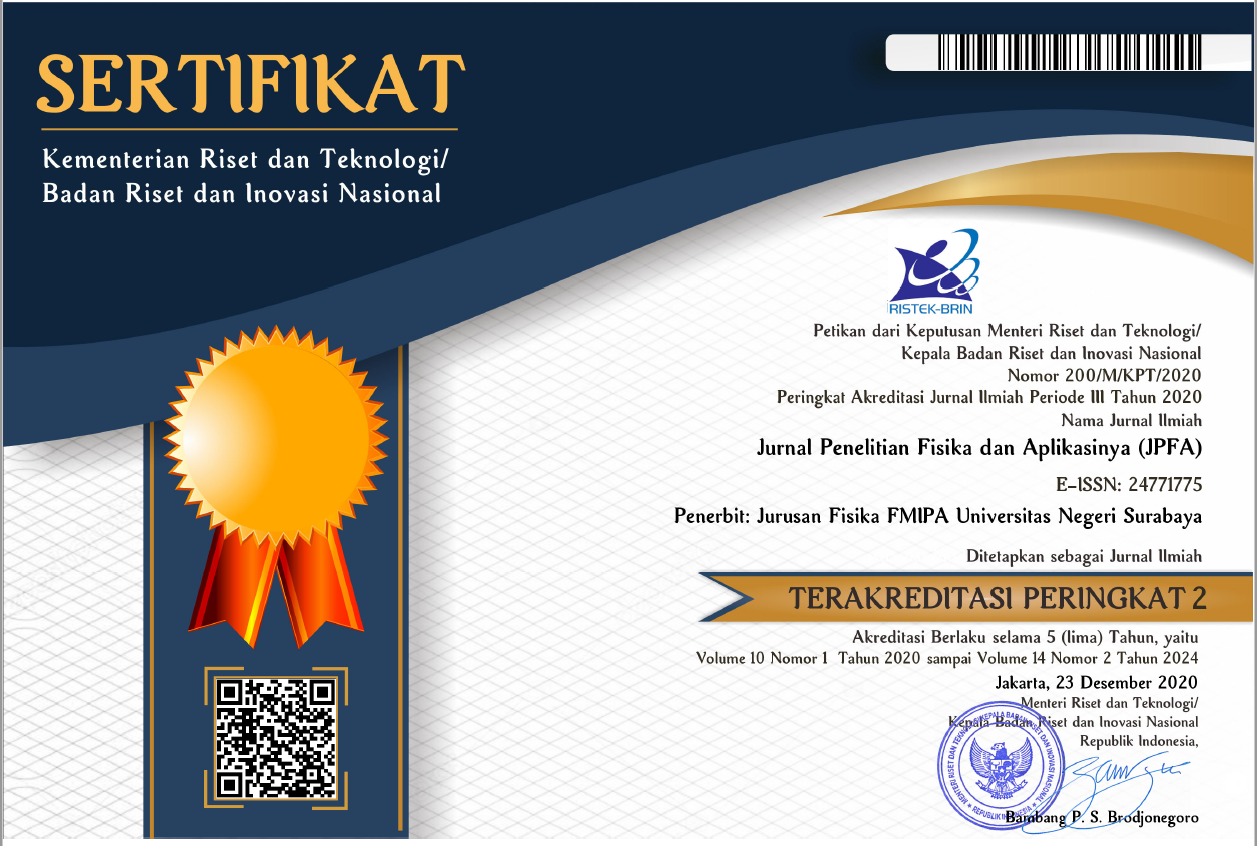Integrating Augmented Reality into Blended Learning for Improved Magnetism Conceptual Understanding
DOI:
https://doi.org/10.26740/jpfa.v14n1.p33-48Keywords:
Augmented Reality, Blended Learning, Conceptual Understanding, MagnetismAbstract
In pursuing innovative educational strategies, this study investigates the integration of Augmented Reality (AR) with blended learning to enhance students' conceptual understanding of magnetism. Utilizing AR as a significant educational tool provides an immersive experience that aids in comprehending complex concepts. At the same time, blended learning combines traditional classroom methods with online resources for a more effective approach. This research employs an experimental design with a pretest-posttest control group involving 60 students from the Islamic University of Raden Intan Lampung enrolled in a physics course on magnetism. The experimental group experienced AR-enhanced blended learning, while the control group received traditional blended learning without AR. Quantitative data analysis included descriptive statistics and the N-Gain test to measure the intervention's effectiveness, with ANOVA used to examine differences in conceptual understanding between the groups. Qualitative data was gathered through semi-structured interviews and analyzed thematically to identify common themes and patterns. The results indicate a significant improvement in the experimental group's understanding of magnetism compared to the control group, highlighting AR's effectiveness in enhancing interactivity and engagement, facilitating the visualization of abstract concepts, and reinforcing the linkage between theory and practical application. These findings offer educators and curriculum developers valuable insights, laying a foundation for future interdisciplinary educational research.
References
Pathania M, Mantri A, Kaur DP, Singh CP, and Sharma B. A Chronological Literature Review of Different Augmented Reality Approaches in Education. Technology, Knowledge and Learning. 2023; 28(1): 329–346. DOI: https://doi.org/10.1007/s10758-021-09558-7.
Topu FB, Yılmaz RM, and Tulgar AT. An Examination of Pre-School Children’s Interaction Levels and Motivation in Learning English with AR-Supported Educational Toys. International Journal of Human–Computer Interaction. 2023; 39(20): 4024–4041. DOI: https://doi.org/10.1080/10447318.2022.2108960.
Kaur DP, Mantri A, and Horan B. Design Implications for Adaptive Augmented Reality Based Interactive Learning Environment for Improved Concept Comprehension in Engineering Paradigms. Interactive Learning Environment. 2022; 30(4): 589–607. DOI: https://doi.org/10.1080/10494820.2019.1674885.
Hajirasouli A and Banihashemi S. Augmented Reality in Architecture and Construction Education: State of The Field and Opportunities. International Journal of Educational Technology in Higher Education. 2022; 19(1): 39. DOI: https://doi.org/10.1186/s41239-022-00343-9.
Nakamura H and Mizuno Y. Development of Augmented-Reality-Based Magnetic Field Visualization System as an Educational Tool. Sensors. 2022; 22(20): 8026. DOI: https://doi.org/10.3390/s22208026.
Priyantini MVD, Sumarjoko B, Widyasari C, Rahmawati LE, and Prastiwi Y. Supporting and Inhibiting Factors Implementation STEAM in Blended Learning Based on Augmented Reality Technology. AIP Conference Proceedings. 2023; 2727: 020039. DOI: https://doi.org/10.1063/5.0141907.
Risdianto E, Masito F, Yustisia N, Macariola JS, Fathurrochman I, and Yunita W. The Effectiveness of Augmented Reality (AR)-Based Blended Learning Models to Increase the Creativity of Prospective Educators. Proceedings of the Mathematics and Science Education International Seminar 2021 (MASEIS 2021). 2023: 71–82. DOI: https://doi.org/10.2991/978-2-38476-012-1_11.
Almusaed A, Almssad A, Yitmen I, and Homod RZ. Enhancing Student Engagement: Harnessing ‘AIED’’s Power in Hybrid Education—A Review Analysis. Education Sciences. 2023; 13(7): 632. DOI: https://doi.org/10.3390/educsci13070632.
Iqbal MZ, Mangina E, and Campbell AG. Current Challenges and Future Research Directions in Augmented Reality for Education. Multimodal Technologies and Interaction. 2022; 6(9): 75. DOI: https://doi.org/10.3390/mti6090075.
Irwanto I, Dianawati R, and Lukman I. Trends of Augmented Reality Applications in Science Education: A Systematic Review From 2007 to 2022. International Journal of Emerging Technologies in Learning (iJET). 2022; 17(13): 157–175. DOI: https://doi.org/10.3991/ijet.v17i13.30587.
Ashraf MA, Mollah S, Perveen S, Shabnam N, and Nahar L. Pedagogical Applications, Prospects, and Challenges of Blended Learning in Chinese Higher Education: A Systematic Review. Frontiers in Psychology. 2022; 12: 772322. DOI: https://doi.org/10.3389/fpsyg.2021.772322.
Ballouk R, Mansour V, Dalziel B, McDonald J, and Hegazi I. Medical Students’ Self-Regulation of Learning in A Blended Learning Environment: A Systematic Scoping Review. Medical Education Online. 2022; 27(1): 2029336. DOI: https://doi.org/10.1080/10872981.2022.2029336.
Bowden JLH. Analogues of Engagement: Assessing Tertiary Student Engagement in Contemporary Face-To-Face and Blended Learning Contexts. Higher Education Research & Development. 2022; 41(4): 997–1012. DOI: https://doi.org/10.1080/07294360.2021.1901666.
Li S and Wang W. Effect of Blended Learning on Student Performance in K‐12 Settings: A Meta‐Analysis. Journal of Computer Assisted Learning. 2022; 38(5): 1254–1272. DOI: https://doi.org/10.1111/jcal.12696.
Wu TT, Lee HY, Li PH, Huang CN, and Huang YM. Promoting Self-Regulation Progress and Knowledge Construction in Blended Learning Via ChatGPT-Based Learning Aid. Journal of Educational Computing Research. 2023; 61(8): 3-31. DOI: https://doi.org/10.1177/07356331231191125.
Alam A and Mohanty A. Evaluation of Software Engineering Virtual Laboratory in Determining Undergraduate Students’ Conceptual Understanding: A Blended Learning Model Using Collaborative-Creative Virtual Learning Environment Employing Critical Pedagogy. In Shakya, S., Du, KL., Ntalianis, K. (eds) Sentiment Analysis and Deep Learning: Proceedings of ICSADL 2022. Singapore: Springer; 2023: 875–899. DOI: https://doi.org/10.1007/978-981-19-5443-6_65.
Anthony B et al. Blended Learning Adoption and Implementation in Higher Education: A Theoretical and Systematic Review. Technology, Knowledge and Learning. 2022; 27: 531-578. DOI: https://doi.org/10.1007/s10758-020-09477-z.
Sudirtha IG, Widiana IW, Setemen K, Sukerti NW, Widiartini NK, and Santiyadnya N. The Impact of Blended Learning Assisted with Self-Assessment toward Learner Autonomy and Creative Thinking Skills. International Journal of Emerging Technologies in Learning (iJET). 2022; 17(6): 163-180. DOI: https://doi.org/10.3991/ijet.v17i06.29799.
Fidan M and Tuncel M. Integrating Augmented Reality into Problem Based Learning: The Effects on Learning Achievement and Attitude in Physics Education. Computers and Education. 2019; 142: 103635. DOI: https://doi.org/10.1016/j.compedu.2019.103635.
Abdusselam MS and Karal H. The Effect of Using Augmented Reality and Sensing Technology to Teach Magnetism in High School Physics. Technology, Pedagogy and Education. 2020; 29(4): 407–424. DOI: https://doi.org/10.1080/1475939X.2020.1766550.
Gholap VB and Li W. Past, Present, and Future of the Augmented Reality (AR)-Enhanced Interactive Techniques: A Survey. Proceeding of 7th International Conference on Machine Vision and Information Technology (CMVIT). 2023: 143–148. DOI: https://doi.org/10.1109/CMVIT57620.2023.00035.
Míguez-Álvarez C, Crespo B, Arce E, Cuevas M, and Regueiro A. Blending Learning as An Approach in Teaching Sustainability. Interactive Learning Environments. 2022; 30(9): 1577–1592. DOI: https://doi.org/10.1080/10494820.2020.1734623.
AlGerafi MA, Zhou Y, Oubibi M, and Wijaya TT. Unlocking The Potential: A Comprehensive Evaluation of Augmented Reality and Virtual Reality in Education. Electronics. 2023; 12(18): 3953. DOI: https://doi.org/10.3390/electronics12183953.
Dargan S, Bansal S, Kumar M, Mittal A, and Kumar K. Augmented Reality: A Comprehensive Review. Archives of Computational Methods in Engineering. 2023; 30(2): 1057–1080. DOI: https://doi.org/10.1007/s11831-022-09831-7.
Hidayat R and Wardat Y. A Systematic Review of Augmented Reality in Science, Technology, Engineering and Mathematics Education. Education and Information Technologies. 2023; 29: 9257–9282. DOI: https://doi.org/10.1007/s10639-023-12157-x.
Vidak A, Mesic A, Šapić IM, and Gomzi V. Augmented Reality Technology in Teaching about Physics: A Systematic Review of Opportunities and Challenges. European Journal of Physics. 2023; 45: 023002. DOI: https://doi.org/10.1088/1361-6404/ad0e84.
Lai JW and Cheong KH. Educational Opportunities and Challenges in Augmented Reality: Featuring Implementations in Physics Education. IEEE Access. 2022; 10: 43143–43158. DOI: https://doi.org/10.1109/ACCESS.2022.3166478.
Hsu K and Liu G. The Construction of a Theory‐Based Augmented Reality‐Featured Context‐Aware Ubiquitous Learning Facilitation Framework for Oral Communication Development. Journal of Computer Assisted Learning. 2023; 39(3): 883-898. DOI: https://doi.org/10.1111/jcal.12792.
Olasina G. Augmented Reality in Higher Education: The New Reality of Teaching and Learning during and Post-COVID-19. Ubiquitous Learning. 2022; 16(1): 31. DOI: https://doi.org/10.18848/1835-9795/CGP/v16i01/31-54.
Bizami NA, Tasir Z, and Kew SN. Innovative Pedagogical Principles and Technological Tools Capabilities for Immersive Blended Learning: A Systematic Literature Review. Education and Information Technologies. 2023; 28(2): 1373–1425. DOI: https://doi.org/10.1007/s10639-022-11243-w.
Buhl-Wiggers J, Kjærgaard A, and Munk K. A Scoping Review of Experimental Evidence on Face-To-Face Components of Blended Learning in Higher Education. Studies in Higher Education. 2023; 48(1): 151–173. DOI: https://doi.org/10.1080/03075079.2022.2123911.
Kinasih RA, Ilmi R, Carmelia N, Rizky A, Prahani BK, and Uulaa RFR. Problem Based Learning Models in Senior High Schools: A Literature Review on Learning Physics. International Journal of Emerging Research and Review. 2023; 1(3): 000036. DOI: https://doi.org/10.56707/ijoerar.v1i3.36.
Marougkas A, Troussas C, Krouska A, and Sgouropoulou C. Virtual Reality in Education: A Review of Learning Theories, Approaches and Methodologies for The Last Decade. Electronics 2023; 12(13): 2832. DOI: https://doi.org/10.3390/electronics12132832.
Fernández-de-Castro P, Aranda D, Moyano S, and Sampedro V. Digital Youth Work: A Systematic Review with A Proposal. Social Work Education. 2023; 42(3): 318–336. DOI: https://doi.org/10.1080/02615479.2021.1971187.
Liu Q, Yu S, Chen W, Wang Q, and Xu S. The Effects of An Augmented Reality Based Magnetic Experimental Tool on Students’ Knowledge Improvement and Cognitive Load. Journal of Computer Assisted Learning. 2021; 37(3): 645–656. DOI: https://doi.org/10.1111/jcal.12513.
Faqih KM and Jaradat MIRM. Integrating TTF and UTAUT2 Theories to Investigate the Adoption of Augmented Reality Technology in Education: Perspective from a Developing Country. Technology in Society. 2021; 67: 101787. DOI: https://doi.org/10.1016/j.techsoc.2021.101787.
Yu J, Denham AR, and Searight E. A Systematic Review of Augmented Reality Game-Based Learning in STEM Education. Educational Technology Research and Development. 2022; 70(4): 1169–1194. DOI: https://doi.org/10.1007/s11423-022-10122-y.
Garzón J. An Overview of Twenty-Five Years of Augmented Reality in Education. Multimodal Technologies and Interaction. 2021; 5(7): 37. DOI: https://doi.org/10.3390/mti5070037.
Sırakaya M and Sırakaya DA. Augmented Reality in STEM Education: A Systematic Review. Interactive Learning Environment. 2022; 30(8): 1556–1569. DOI: https://doi.org/10.1080/10494820.2020.1722713.
Alamsyah DP, Parulian JM, and Herliana A. Augmented Reality Android Based: Education of Modern and Traditional Instruments. Procedia Computer Science. 2023; 216: 266–273. DOI: https://doi.org/10.1016/j.procs.2022.12.136.
Gao S, Lu Y, Ooi CH, Cai Y, and Gunawan P. Designing Interactive Augmented Reality Application for Student’s Directed Learning of Continuous Distillation Process. Computers and Chemical Engineering. 2023; 169: 108086. DOI: https://doi.org/10.1016/j.compchemeng.2022.108086.
Hilken T, Heller J, Keeling DI, Chylinski M, Mahr D, and de Ruyter K. Bridging Imagination Gaps on the Path to Purchase with Augmented Reality: Field and Experimental Evidence. Journal of Interactive Marketing. 2022; 57(2): 356–375. DOI: https://doi.org/10.1177/10949968221083555.
Singh G, Mantri A, Sharma O, Dutta R, and Kaur R. Evaluating the Impact of the Augmented Reality Learning Environment on Electronics Laboratory Skills of Engineering Students. Computer Applications in Engineering Education. 2019; 27(6): 1361–1375. DOI: https://doi.org/10.1002/cae.22156.
Dutta R, Mantri A, and Singh G. Evaluating System Usability of Mobile Augmented Reality Application for Teaching Karnaugh-Maps. Smart Learning Environments. 2022; 9(1): 6. DOI: https://doi.org/10.1186/s40561-022-00189-8.
Chou YY et al. Effect of Digital Learning Using Augmented Reality with Multidimensional Concept Map in Elementary Science Course. Asia-Pacific Education Research. 2022; 31(4): 383–393. DOI: https://doi.org/10.1007/s40299-021-00580-y.
Faridi H, Tuli N, Mantri A, Singh G, and Gargrish S. A Framework Utilizing Augmented Reality to Improve Critical Thinking Ability and Learning Gain of the Students in Physics. Computer Applications in Engineering Education. 2021; 29(1): 258–273. DOI: https://doi.org/10.1002/cae.22342.
Turan Z, Meral E, and Sahin IF. The Impact of Mobile Augmented Reality in Geography Education: Achievements, Cognitive Loads and Views of University Students. Journal of Geography in Higher Education. 2018; 42(3): 427–441. DOI: https://doi.org/10.1080/03098265.2018.1455174.
Wen Y. Augmented Reality Enhanced Cognitive Engagement: Designing Classroom-Based Collaborative Learning Activities for Young Language Learners. Educational Technology Research and Development. 2021; 69(2): 843–860. DOI: https://doi.org/10.1007/s11423-020-09893-z.
Arici F, Yildirim P, Caliklar Ş, and Yilmaz RM. Research Trends in The Use of Augmented Reality in Science Education: Content and Bibliometric Mapping Analysis. Computers and Education. 2019; 142: 103647. DOI: https://doi.org/10.1016/j.compedu.2019.103647.
Cai S, Liu C, Wang T, Liu E, and Liang J. Effects of Learning Physics Using Augmented Reality on Students’ Self‐Efficacy and Conceptions of Learning. British Journal of Educational Technology. 2021; 52(1): 235–251. DOI: https://doi.org/10.1111/bjet.13020.
Downloads
Additional Files
Published
How to Cite
Issue
Section
License
Copyright (c) 2024 Jurnal Penelitian Fisika dan Aplikasinya (JPFA)

This work is licensed under a Creative Commons Attribution-NonCommercial 4.0 International License.
Author(s) who wish to publish with this journal should agree to the following terms:
- Author(s) retain copyright and grant the journal right of first publication with the work simultaneously licensed under a Creative Commons Attribution-Non Commercial 4.0 License (CC BY-NC) that allows others to share the work with an acknowledgement of the work's authorship and initial publication in this journal for noncommercial purposes.
- Author(s) are able to enter into separate, additional contractual arrangements for the non-exclusive distribution of the journal's published version of the work (e.g., post it to an institutional repository or publish it in a book), with an acknowledgement of its initial publication in this journal.
The publisher publish and distribute the Article with the copyright notice to the JPFA with the article license CC-BY-NC 4.0.
 Abstract views: 434
,
Abstract views: 434
, PDF Downloads: 298
,
PDF Downloads: 298
, PDF Downloads: 0
PDF Downloads: 0








